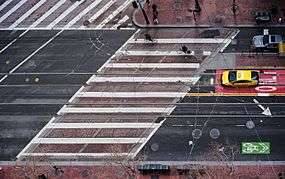Fear of crossing streets
The fear of crossing streets, or its terms dromophobia and agyrophobia, is a specific phobia that affects a person's ability to cross a street or roadway where cars or vehicles may be present. The term dromophobia comes from the Greek dromos, meaning racetrack.

Causes of dromophobia
Dromophobia may result from experiencing a road accident and thus may be classified as a subtype of panic disorder with agoraphobia (PDA).[1] As such, dromophobia, especially fear of crossing streets alone may be a component of accident-related posttraumatic stress disorder, as a reaction to a situation reminiscent of the past traumatic event.[2][3] Sometimes this behavior may be misinterpreted during PTSD symptom assessment as a caution (i.e., a normal learning behavior) rather than fear (which is an abnormal avoidant behavior). [4]
Fear of crossing streets may also result from an anticipatory anxiety related to person's limited mobility due to stiff person syndrome (SPS). In fact a person with SPS crossing a street may develop attacks of increasing stiffness or spasms.[5]
Dromophobia may be present in people, especially children, with autism, since crossing a road involves complex skills, such as judging the speed of an approaching car.[6]
See also
Further reading
- Szasz, Thomas. A Lexicon of Lunacy. Transaction Publishers, 1993. ISBN 9781560000655. p 66.
References
- Page, Andrew (1994). "Distinguishing Panic Disorder and Agoraphobia from Social Phobia". Journal of Nervous & Mental Disease. 182 (11).
- Kuch, Klaus (November–December 1995). "A Brief Self-Rating Scale for PTSD After Road Vehicle Accident". Journal of Anxiety Disorders. 9 (6): 503–514. doi:10.1016/0887-6185(95)00029-n.
- Keppel-Benson, Jane M.; Ollendick, Thomas H.; Benson, Mark J. (February 2002). "Post-Traumatic Stress in Children Following Motor Vehicle Accidents". Journal of Child Psychology and Psychiatry. 43 (2): 203–212. doi:10.1111/1469-7610.00013.
- Scheeringa, Michael S. (2011). "PTSD in Children Younger than the Age of 13". Journal of Child & Adolescent Trauma. 4 (3): 181–197. doi:10.1080/19361521.2011.597079. PMC 6379904. PMID 30792828. Also in: Assessment of Trauma in Youths. 2016. pp. 21–36. ISBN 1134905963 – via Google Books.
- Rodrigues de Cerqueira, Ana Claudia; Ferreira Becerra, José Marcelo; Rozentha, Márcia; Emídio Nardi, Antônio (August 2010). "Stiff-Person Syndrome and Generalized Anxiety Disorder". Arquivos de Neuro-Psiquiatria. 68 (4): 659–661. doi:10.1590/S0004-282X2010000400036.
- Strickland, Dorothy (1996). "A Virtual Reality Application with Autistic Children". Presence. MIT Press Journals. 5 (3): 319–329. doi:10.1162/pres.1996.5.3.319.